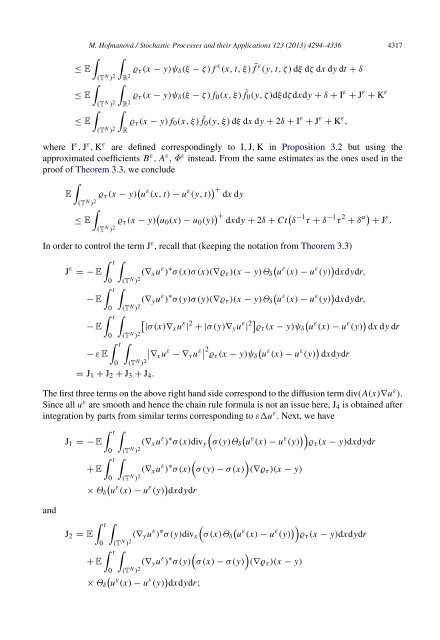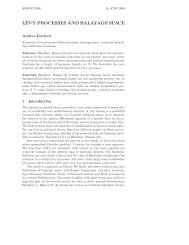Degenerate parabolic stochastic partial differential equations
Degenerate parabolic stochastic partial differential equations
Degenerate parabolic stochastic partial differential equations
Create successful ePaper yourself
Turn your PDF publications into a flip-book with our unique Google optimized e-Paper software.
M. Hofmanová / Stochastic Processes and their Applications 123 (2013) 4294–4336 4317<br />
<br />
≤ E ϱ τ (x − y)ψ δ (ξ − ζ ) f<br />
(T ε (x, t, ξ) f¯<br />
ε (y, t, ζ ) dξ dζ dx dy dt + δ<br />
N ) 2 R<br />
<br />
2<br />
≤ E ϱ τ (x − y)ψ δ (ξ − ζ ) f 0 (x, ξ) f¯<br />
0 (y, ζ )dξdζ dxdy + δ + I<br />
(T ε + J ε + K ε<br />
N ) 2 R<br />
<br />
2<br />
≤ E ϱ τ (x − y) f 0 (x, ξ) f¯<br />
0 (y, ξ) dξ dx dy + 2δ + I<br />
(T ε + J ε + K ε ,<br />
N ) 2 R<br />
where I ε , J ε , K ε are defined correspondingly to I, J, K in Proposition 3.2 but using the<br />
approximated coefficients B ε , A ε , Φ ε instead. From the same estimates as the ones used in the<br />
proof of Theorem 3.3, we conclude<br />
<br />
E ϱ τ (x − y) u ε (x, t) − u ε (y, t) + dx dy<br />
(T N )<br />
<br />
2<br />
≤ E ϱ τ (x − y) u 0 (x) − u 0 (y) + <br />
dxdy + 2δ + Ct δ −1 τ + δ −1 τ 2 + δ α + J ε .<br />
(T N ) 2<br />
In order to control the term J ε , recall that (keeping the notation from Theorem 3.3)<br />
t <br />
J ε = − E (∇ x u ε ) ∗ <br />
σ (x)σ (x)(∇ϱ τ )(x − y)Θ δ u ε (x) − u ε (y) dxdydr,<br />
0 (T N )<br />
2 t <br />
− E (∇ y u ε ) ∗ <br />
σ (y)σ (y)(∇ϱ τ )(x − y)Θ δ u ε (x) − u ε (y) dxdydr,<br />
0 (T N )<br />
2 t <br />
<br />
− E |σ (x)∇x u ε | 2 + |σ (y)∇ y u ε | 2 <br />
ϱ τ (x − y)ψ δ u ε (x) − u ε (y) dx dy dr<br />
0 (T N )<br />
2 t <br />
<br />
− ε E<br />
∇ x u ε − ∇ y u ε 2 <br />
ϱ τ (x − y)ψ δ u ε (x) − u ε (y) dxdydr<br />
0 (T N ) 2<br />
= J 1 + J 2 + J 3 + J 4 .<br />
The first three terms on the above right hand side correspond to the diffusion term div(A(x)∇u ε ).<br />
Since all u ε are smooth and hence the chain rule formula is not an issue here, J 4 is obtained after<br />
integration by parts from similar terms corresponding to εu ε . Next, we have<br />
J 1 = − E<br />
t<br />
0<br />
t<br />
(T N ) 2 (∇ x u ε ) ∗ σ (x)div y<br />
<br />
σ (y)Θ δ<br />
<br />
u ε (x) − u ε (y) ϱ τ (x − y)dxdydr<br />
<br />
<br />
<br />
+ E (∇ x u ε ) ∗ σ (x) σ (y) − σ (x) (∇ϱ τ )(x − y)<br />
0 (T N )<br />
2<br />
× Θ δ u ε (x) − u ε (y) dxdydr<br />
and<br />
t<br />
J 2 = E<br />
0<br />
t<br />
(T N ) 2 (∇ y u ε ) ∗ σ (y)div x<br />
<br />
σ (x)Θ δ<br />
<br />
u ε (x) − u ε (y) ϱ τ (x − y)dxdydr<br />
<br />
<br />
<br />
+ E (∇ y u ε ) ∗ σ (y) σ (x) − σ (y) (∇ϱ τ )(x − y)<br />
0 (T N )<br />
2<br />
× Θ δ u ε (x) − u ε (y) dxdydr;



